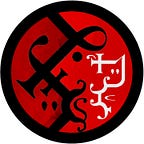The Voidic Creed
The Orcish Kingdoms, especially those of the North, are geographically dominated by sinkholes, crevasses, and pits. Many of these formations, due to the spatial aberrations of the post-Collapse universe, are literally bottomless- or, rather, their bottoms are so distant that they end beneath reality itself.
These are slivers of Elemental Void: they connect the world to the nothingness outside existence. Once, this place was full of dimensions, planes, spiritual kingdoms, and afterlife realms; now, all of these have cascaded inward, leaving nothing, not even space itself.
Zawba’ah, last of the Djinn, was stricken with guilt over the defilement of the world after the Heavenly War and the Collapse. She ventured into the Void in search of her Creator, hoping it would return to fix everything- righting the wrongs she and the other divinities had committed. Into the perfect dark she descended, with the orcs, her “Children of the Tempest”, in attendance. She promised to return as soon as she could. She never returned.
In honor of their beloved goddess, penitent monks of the Order of the Void continue her mission to reach the Demiurge, the true God above all, down in the lightless pits where nothing is.
Orcish Void-Sisters are the only ones lowered regularly into the Pits: accompanied by the deep chants of the male monks, they are lowered into the holes by ropes of entwined amulets. In the dark, they disrobe and empty their minds to reflect the featureless nothingness around them. After a set amount of time- the more experienced the nun, the longer the interval- the sisters are pulled out, bringing their experiences of the Deep with them. Usually this is something irrelevant- some paraphrase of common wisdom, some variation on known holy imageries. Sometimes they bring back prophecies, true penetrations into the fabric of reality, chilling omens, and enlightening parables.
This ritual is the basis upon which all weekly rites and private prayers are constructed. Devotees to the Voidic Creed aim to “look beneath,” and to do so they “look within,” through meditation. Voidic sacred scriptures state that there is a fragment of Void inside the Soul, much as there is dark in the center of any flame, and that small opening can be the passage to the True Deep and the voice of the Demiurge.
Any hole, pit, well, or fissure with no visible floor is a suitable location for prayer. Over the centuries, however, high priests of the Order have developed Void Rugs (Hutsa Maindire). As a user prays upon the pitch-black carpet, they sink lower and lower, the rug transforming into a hole becoming deeper and deeper. Voidic sanctuaries are completely carpeted around a central well, with all attendants sitting around it in concentric circles. The lower each penitent sinks, the truer their “emptying”.
The central role of meditation in orcish culture may apparently clash with the stereotype of them as a volatile and fiery people. Some claim that because they are such an irascible and emotional society, they seek some peace of mind as a balancing act. Certain Imperial Anatomists have hypothesized that orcs possess an additional gland in their brains which produces a “rage humor,” and the practice of emptiness through meditation deactivates this section of their cerebra- a theory with no observable evidence.
From another perspective, meditation practices are also often used by warriors in order to enhance the warrior spirit. The “battle trance,” the state in which the sense of self “vanishes into violence,” is the ultimate goal of many martial disciplines. The masters of the dual axe perform pre-battle meditations to achieve the “Cold Frenzy,” a state of hyperfocus comparable to such a trance.
But almost all castes of all cultures dedicated to all different kinds of activities have some tradition involving “ego death,” the cessation of conscious thought in the waking mind- from the sungazing dervishes that blind themselves in search of ecstasy, to the miners in the mountains that achieve a dissociative state to endure their grueling work.
While the orcs fought alongside the angels during the Heavenly War, their religion nearly turned them against their allies. Their deity Zawba’ah blamed everyone for the war; the angels were less guilty than the devils, but not innocent. The Angelic Unison made many missionary efforts in order to bring Voidic penitents “into the fold.” Famously, they succeeded in converting the Northern King Jentil II in the third century. While almost causing a civil war, this event also brought about some level of syncretism. For example, the mysterious voices that meditating sisters often hear in the void are attributed to Efes-El, the Angel of Absence; many tales and parables about the righteousness of the Angels and the evils of Devils were introduced to weekly prayers; the prophecies about the Demiurge’s return were aligned with the calendar of the Celestial Church; and so on.
Most of these Angelic elements exist in the liturgy of the Voidic Creed to this day, but are seen more as ornamental trappings or helpful metaphors. For example, penitents largely refer to Efes-El as a way to understand or describe the voice of the Demiurge, not an actual being. For some sects, this is still too much, and some sects advocate for purging all Angelic influences from the Voidic religion. This schism helped drive the recent Orc Civil War and subsequent fission within the Northern and Southern Kingdoms. The more radical sects have aligned with the South, in an attempt to overthrow the traditional (and, in their view, tainted) clergy caste. They succeeded in part, pushing the southern clergy to remove a good chunk of Angelic symbolism from temples and liturgy, but new problems are brewing: the Southern Queen is pushing for modernization, and that will eventually clash with the hyper-traditionalist views of these sects.
